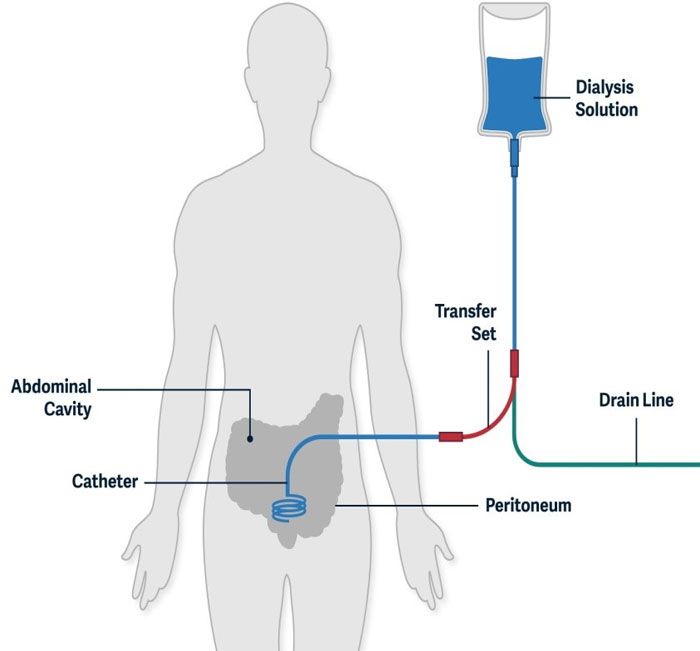Peritoneal Dialysis
 Doing dialysis from home through a process called Peritoneal Dialysis (PD) allows you more freedom and flexibility with your day-to-day schedules. Unlike in-center treatments, once you have completed training, you only have to come to clinic twice a month, once to get your labs drawn and then again to meet with your Doctor on a designated day.
Doing dialysis from home through a process called Peritoneal Dialysis (PD) allows you more freedom and flexibility with your day-to-day schedules. Unlike in-center treatments, once you have completed training, you only have to come to clinic twice a month, once to get your labs drawn and then again to meet with your Doctor on a designated day.
PD is a daily treatment. During the PD process a warmed solution, called dialysate, enters your peritoneal cavity (part of your abdominal cavity) through a small catheter that is surgically placed there as an access point. It absorbs wastes, chemicals, and excess fluid from your body using the natural lining of your abdomen to filter your blood and is then drained and replaced with fresh dialysate.
 The peritoneal membrane acts as the artificial kidney. It has many tiny holes or pores in it that can be used to filter waste products and other chemicals from your blood. A permanent catheter which is placed by a surgeon in your lower abdomen will carry a solution in and out of the abdomen. The sugar in the solution, called dextrose, draws wastes, chemicals, and extra fluid from your blood through the peritoneal membrane and into the dialysate solution that is in your abdomen. After several hours the used solution is drained from your abdomen through the catheter to an empty bag. Your abdomen is then refilled with a fresh solution and the process is repeated. Each cycle of draining and refilling is called an exchange.
The peritoneal membrane acts as the artificial kidney. It has many tiny holes or pores in it that can be used to filter waste products and other chemicals from your blood. A permanent catheter which is placed by a surgeon in your lower abdomen will carry a solution in and out of the abdomen. The sugar in the solution, called dextrose, draws wastes, chemicals, and extra fluid from your blood through the peritoneal membrane and into the dialysate solution that is in your abdomen. After several hours the used solution is drained from your abdomen through the catheter to an empty bag. Your abdomen is then refilled with a fresh solution and the process is repeated. Each cycle of draining and refilling is called an exchange.
CAPD/CCPD training will take anywhere from 10-15 days. During this time, the patient is trained by the CAPD staff to safely perform their therapy at home. There are no needles in this type of treatment, and patients have options to dialyze during waking or sleeping hours, allowing for more flexibility. You will need approximately 25 square feet of storage space for your home dialysis supplies.
There are two types of peritoneal dialysis utilized at FSRDC: CAPD and CCPD (You will be trained on both).
CAPD:
Continuous Ambulatory Peritoneal Dialysis is a form of self-home dialysis that uses the peritoneal cavity as the dialysis membrane. This type of therapy requires insertion of a permanent peritoneal catheter and is a continuous process involving 4 exchanges per day.
CCPD:
Continuous Cycling Peritoneal Dialysis is another form of Peritoneal dialysis which utilizes a machine to perform the exchanges of dialysis solution. A partner is not required to assist with this therapy which occurs at night.